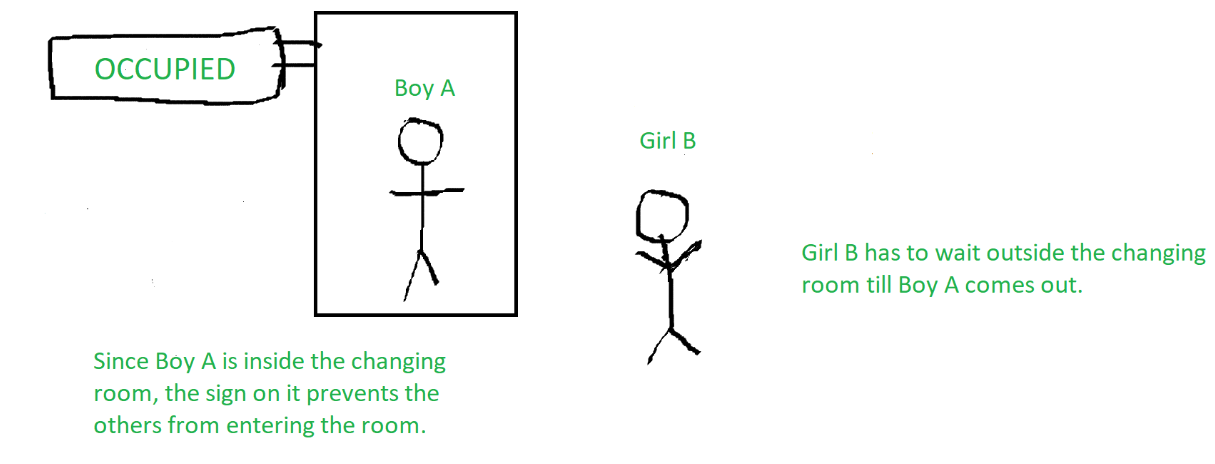Mutual Exclusion: It is some way of making sure that if one process is using a shared variable or file, the other process will be excluded from doing the somethings.
The difficulty in printer spooler occurs because process B started using one of the shared variables before process A was finished with it. If we could arrange matter such that no two processes were ever in there critical regions at at the same time, we could avoid race conditions.
To understand mutual exclusion, let’s take an example.
Example:
In the clothes section of a supermarket, two people are shopping for clothes.
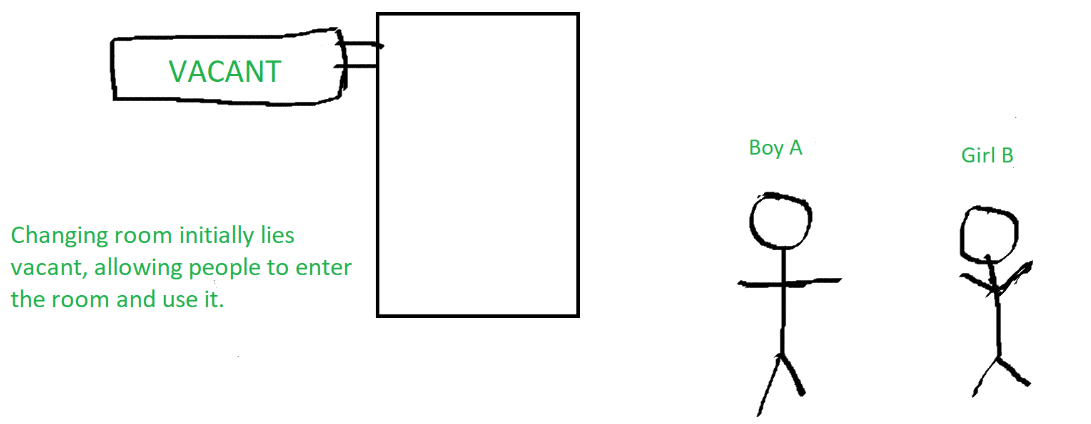
Boy A decides upon some clothes to buy and heads to the changing room to try them out. Now, while boy A is inside the changing room, there is an ‘occupied’ sign on it – indicating that no one else can come in. Girl B has to use the changing room too, so she has to wait till boy A is done using the changing room.
Once boy A comes out of the changing room, the sign on it changes from ‘occupied’ to ‘vacant’ – indicating that another person can use it. Hence, girl B proceeds to use the changing room, while the sign displays ‘occupied’ again.
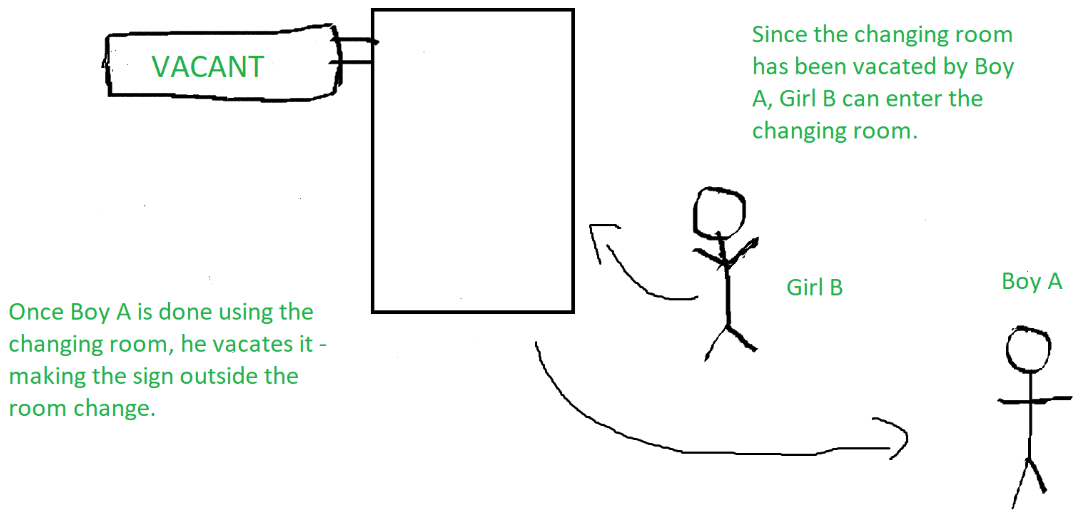
The changing room is nothing but the critical section, boy A and girl B are two different processes, while the sign outside the changing room indicates the process synchronization mechanism being used.
ALSO READ
Operating System Study materials
![]()
Operating System Technigoo Publication Book
What is thrashing?
A state in which the CPU performs lesser “productive” work and more “swapping” is known as thrashing.
It occurs when there are too many pages in the memory and each page refers to another one.
The CPU is busy swapping and hence its utilization falls.
What are the causes of thrashing?
The process scheduling mechanism tries to load many processes in the system at a time and hence the degree of multiprogramming is increased. In this scenario, there are far more processes than the number of frames available.
The memory soon fills up and the process starts spending a lot of time for the required pages to be swapped in, causing the utilization of the CPU to fall low, as every process has to wait for pages.
Effect of thrashing?
When the operating system encounters a situation of thrashing then it tries to apply the following algorithms:
- Global page replacement
- Local page replacement
Global page replacement
Whenever there is thrashing, the global page replacement algorithm tries to bring more pages.
Though, this is not a suitable algorithm as in this no process can get enough frames causing more thrashing.
Local page replacement
This algorithm may help in the reduction of thrashing as it brings pages that belongs to the process.
But there are many other disadvantages of local page replacement and hence it is only used as an alternative for global page replacement.
What is Thread?
A thread is a flow of execution through the process code, with its own program counter that keeps track of which instruction to execute next, system registers which hold its current working variables, and a stack which contains the execution history.
A thread shares with its peer threads few information like code segment, data segment and open files. When one thread alters a code segment memory item, all other threads see that.
A thread is also called a lightweight process. Threads provide a way to improve application performance through parallelism. Threads represent a software approach to improving performance of operating system by reducing the overhead thread is equivalent to a classical process.
Each thread belongs to exactly one process and no thread can exist outside a process. Each thread represents a separate flow of control. Threads have been successfully used in implementing network servers and web server. They also provide a suitable foundation for parallel execution of applications on shared memory multiprocessors. The following figure shows the working of a single-threaded and a multithreaded process.
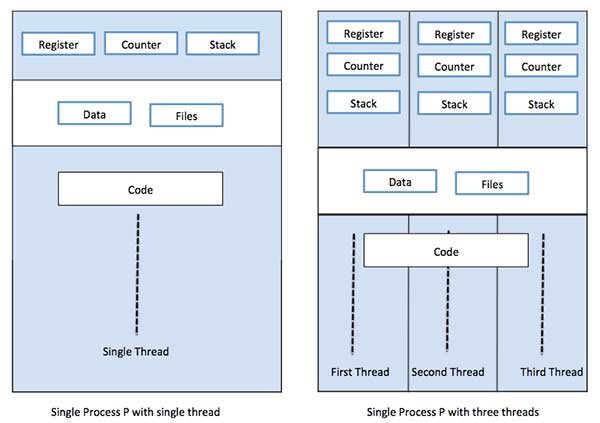
Difference between Process and Thread
| S.N. | Process | Thread |
|---|---|---|
| 1 | Process is heavy weight or resource intensive. | Thread is light weight, taking lesser resources than a process. |
| 2 | Process switching needs interaction with operating system. | Thread switching does not need to interact with operating system. |
| 3 | In multiple processing environments, each process executes the same code but has its own memory and file resources. | All threads can share same set of open files, child processes. |
| 4 | If one process is blocked, then no other process can execute until the first process is unblocked. | While one thread is blocked and waiting, a second thread in the same task can run. |
| 5 | Multiple processes without using threads use more resources. | Multiple threaded processes use fewer resources. |
| 6 | In multiple processes each process operates independently of the others. | One thread can read, write or change another thread's data. |
Advantages of Thread
- Threads minimize the context switching time.
- Use of threads provides concurrency within a process.
- Efficient communication.
- It is more economical to create and context switch threads.
- Threads allow utilization of multiprocessor architectures to a greater scale and efficiency.
Types of Thread
Threads are implemented in following two ways −
User Level Threads − User managed threads.
Kernel Level Threads − Operating System managed threads acting on kernel, an operating system core.
User Level Threads
In this case, the thread management kernel is not aware of the existence of threads. The thread library contains code for creating and destroying threads, for passing message and data between threads, for scheduling thread execution and for saving and restoring thread contexts. The application starts with a single thread.
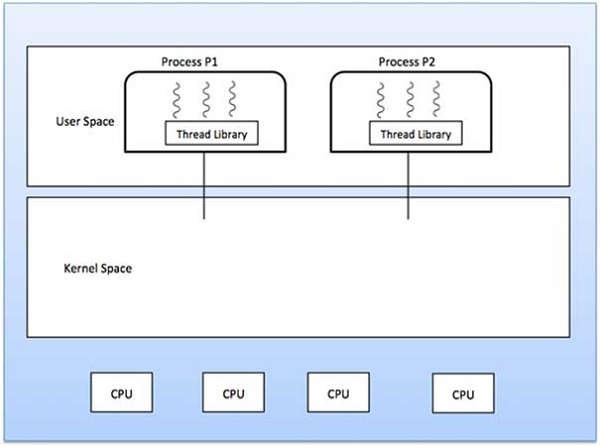
Advantages
- Thread switching does not require Kernel mode privileges.
- User level thread can run on any operating system.
- Scheduling can be application specific in the user level thread.
- User level threads are fast to create and manage.
Disadvantages
- In a typical operating system, most system calls are blocking.
- Multithreaded application cannot take advantage of multiprocessing.
Kernel Level Threads
In this case, thread management is done by the Kernel. There is no thread management code in the application area. Kernel threads are supported directly by the operating system. Any application can be programmed to be multithreaded. All of the threads within an application are supported within a single process.
The Kernel maintains context information for the process as a whole and for individuals threads within the process. Scheduling by the Kernel is done on a thread basis. The Kernel performs thread creation, scheduling and management in Kernel space. Kernel threads are generally slower to create and manage than the user threads.
Advantages
- Kernel can simultaneously schedule multiple threads from the same process on multiple processes.
- If one thread in a process is blocked, the Kernel can schedule another thread of the same process.
- Kernel routines themselves can be multithreaded.
Disadvantages
- Kernel threads are generally slower to create and manage than the user threads.
- Transfer of control from one thread to another within the same process requires a mode switch to the Kernel.
Multithreading Models
Some operating system provide a combined user level thread and Kernel level thread facility. Solaris is a good example of this combined approach. In a combined system, multiple threads within the same application can run in parallel on multiple processors and a blocking system call need not block the entire process. Multithreading models are three types
- Many to many relationship.
- Many to one relationship.
- One to one relationship.
Many to Many Model
The many-to-many model multiplexes any number of user threads onto an equal or smaller number of kernel threads.
The following diagram shows the many-to-many threading model where 6 user level threads are multiplexing with 6 kernel level threads. In this model, developers can create as many user threads as necessary and the corresponding Kernel threads can run in parallel on a multiprocessor machine. This model provides the best accuracy on concurrency and when a thread performs a blocking system call, the kernel can schedule another thread for execution.
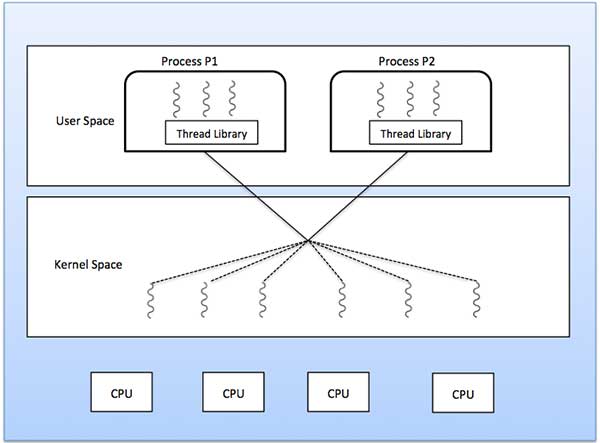
Many to One Model
Many-to-one model maps many user level threads to one Kernel-level thread. Thread management is done in user space by the thread library. When thread makes a blocking system call, the entire process will be blocked. Only one thread can access the Kernel at a time, so multiple threads are unable to run in parallel on multiprocessors.
If the user-level thread libraries are implemented in the operating system in such a way that the system does not support them, then the Kernel threads use the many-to-one relationship modes.
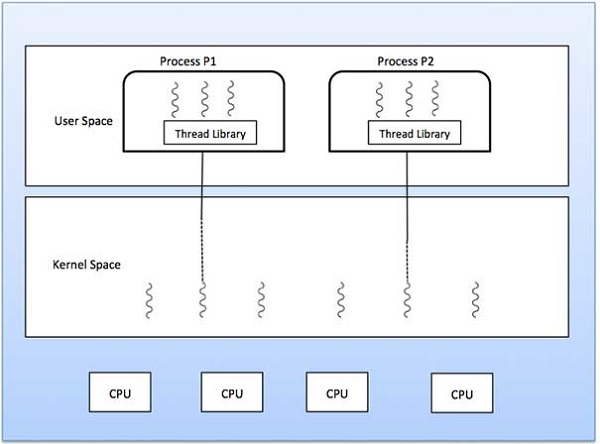
One to One Model
There is one-to-one relationship of user-level thread to the kernel-level thread. This model provides more concurrency than the many-to-one model. It also allows another thread to run when a thread makes a blocking system call. It supports multiple threads to execute in parallel on microprocessors.
Disadvantage of this model is that creating user thread requires the corresponding Kernel thread. OS/2, windows NT and windows 2000 use one to one relationship model.
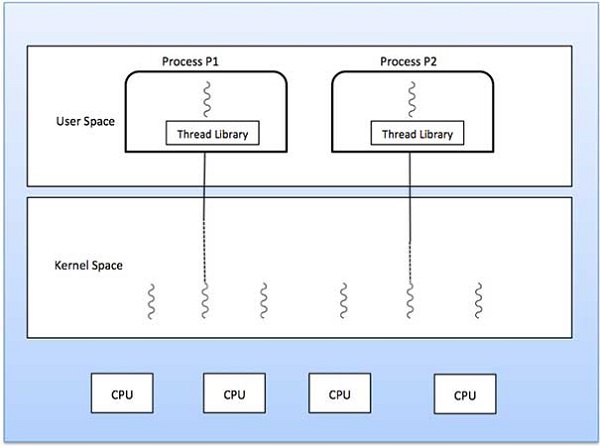
Difference between User-Level & Kernel-Level Thread
| S.N. | User-Level Threads | Kernel-Level Thread |
|---|---|---|
| 1 | User-level threads are faster to create and manage. | Kernel-level threads are slower to create and manage. |
| 2 | Implementation is by a thread library at the user level. | Operating system supports creation of Kernel threads. |
| 3 | User-level thread is generic and can run on any operating system. | Kernel-level thread is specific to the operating system. |
| 4 | Multi-threaded applications cannot take advantage of multiprocessing. | Kernel routines themselves can be multithreaded. |
Related Questions & Answers
- What are the Process States in Operating System?
- Write about Process Control Block.
- Write Various Operating System Services.
- What is the requirement to solve the Critical Section Problem?
- Write about the Priority Inversion Problem.
- Write various multithreading models.
- Discuss preemptive scheduling.
- Consider the following set of processes........
- Write about Semaphores. Explain its properties along with drawbacks.
- Write necessary conditions for arise of Deadlock.
- Define the following Terms: Mutual Exclusion, Thrashing, Thread
- Explain the features of Time sharing system.
- What is an operating system? Give the view of OS as a resource manager.
- Explain the following UNIX Commands: (a) grep (b) chmod (c) finger (d) cat (e) sort
- What is the thread? Explain thread Structure? And explain any one type of thread in detail.
- What is PCB? Discuss its major fields.
- List the four events that cause processes to be created. Explain each in brief.
- Explain the producer-consumer problem and its solution using the monitor.
- List Deadlock recovery techniques and explain any one of them.
- Write a short note in Critical Section.
- Explain context switching.
- Differentiate between Multi-Programming and Multi-Processing System.
- Write different types of system calls?
- What is a scheduler? Explain queuing diagram representation of process scheduler.
- Define the following Terms: Throughput, Waiting Time, Turnaround Time, Response Time.
- What is deadlock? List the conditions that lead to deadlock.
- Explain Banker’s algorithm for multiple resources with examples.
- What is Semaphore? Give the implementation of Bounded Buffer.
- What is Mutex? Write pseudocode to achieve mutual exclusion using Mutex.
- Explain the IPC problem. Explain the Dining Philosopher problem.

